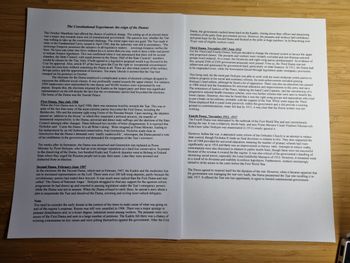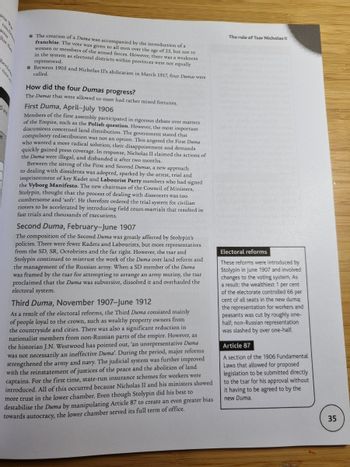Question
Context: Russia 1905-1907
Using the info from the sheets, categorise them into these sections
(only for the First and Second Dumas)
- Main parties/ key people (in the Duma)
- Success
- Failures/problems
- Other important points

Transcribed Image Text:The Constitutional Experiment: the reign of the Dumas
The October Manifesto had offered the chance of political change. The setting up of an elected duma
was a major step towards some sort of constitutional government. The question was, whether the Tsar
was willing to take up the constitutional challenge. The initial signs were not good. The Tsar made it
clear in the Fundamental Laws, issued in April 1906, that the autocracy was still in ascendancy. "The
sovereign Emperor possesses the initiative in all legislative matters... sovereign Emperor ratifies the
laws.
No laws can come into force without his a it seems that you may wish to have a little real power
to initiate finance legislation. This was confirmed when it was announced that there will be second
chamber, the State Council, with equal powers to the Duma. Half of the State Councils' members
would be chosen by the Tsar. Only if both agreed to a legislative proposal would it go forward to the
Czar for approval. Also, article 87 of the laws gave the Czar the right in 'exceptional circumstances
to pass his own laws without consulting the Duma at all. These are also retain control of the military,
foreign policy and the appointment of ministers. Too many liberals it seemed that the Tsar had
reneged on his promises in October.
The elections for the Duma employed a complicated system of electoral colleges designed to
represent the different social classes. It was profoundly waited towards the upper classes. For instance,
2000 landowners were represented by one deputy and 90,000 workers were represented by one
deputy. Despite this, the elections returned the Kadets as the largest party and there was significant
representation on the left despite the fact that the revolutionary parties had boycotted the elections.
The home of the Duma was the Tauride Palace.
First Duma, May-July 1906
When the First Duma met in April 1906, there was immense hostility towards the Tsar. This was in
spite of the fact that many of the more extreme parties boycotted the First Duma, including the
Bolsheviks, SRs and the extreme right wing Union of the Russian People. Upon meeting, the deputies
passed an 'address to the throne' in which they requested a political amnesty, the transfer of
ministerial responsibility to the Duma, universal and direct male suffrage and the abolition of the State
Council amongst other changes. There followed two months of bitter disagreement. It is reported that
Nicholas said: 'Curse the Duma. It is all Witte's doing'. Witte resigned as Prime Minister, leading to
his replacement by an old fashioned conservative, Ivan Goremykin. Nicholas made clear to
Goremykin that the Duma's demands were 'totally inadmissible', whereupon, the Duma passed a vote
of no confidence in the government and demanded the resignation of the Tsar's ministers.
Ten weeks after its formation, the Duma was dissolved and Goremykin was replaced as Prime
Minister by Pyotr Stolypin, who had an even stronger reputation as a hard-line conservative. In protest
to the dissolving of the Duma, two hundred Kadet and Trudovik deputies went to Byborg in Finland
from where they urged the Russian people not to pay their taxes. Later they were arrested and
disbarred from re-election.
Second Duma, February-June 1907
In the elections for the Second Duma, which met in February 1907, the Kadets and the moderates lost
out to increased representation on the Left. There were over 200 left-wing deputies, partly because the
revolutionary parties had ended their boycott. It was much more radical than the First Duma and was
called "The Duma of National Anger'. Stolypin struggled to find any support for the agrarian reform
programme he had drawn up and resorted to passing legislation under the Tsar's emergency powers
while the Duma was not in session. When the Duma refused to ratify these, he spread a story about a
plot to assassinate the Tsar and dissolved the Duma, arresting and exiling more radical delegates.
Note:
You need to consider the early dumas in the context of the times to make sense of what was going on
and of the regime's response. Russia was still very unsettled in 1906. There was a major upsurge in
peasant disturbances and, to a lesser degree, industrial unrest among workers. The peasants were very
aware of the First Duma and sent in a large number of petitions. The Kadets felt there was a chance of
winning concessions on key issues and were pitting themselves against the government. After the First
Duma, the government cracked down hard on the Kadets, closing down their offices and dismissing
members of the party from government service. However, the peasants and workers had confidence
and great hope for the Second Duma and flocked to the polls in huge numbers. In St Petersburg over
70 per cent of eligible workers voted
Third Duma, November 1907-June 1912
For the Third (and Fourth) Duma, Stolypin decided to change the electoral system to favour the upper
and propertied classes. The peasants and workers were virtually excluded and non-Russian national
groups much reduced. As a result, the Octobrists and right-wing parties predominated. As evidence of
this, around 2200 of 2500 government proposals were passed. Even so, the Third Duma was not
subservient and questioned the government hard, particularly on state finances. In 1911, the Duma had
to be suspended twice, while the fovernment forced through legislation under emergency provisions.
This being said, for the most part Stolypin was able to work with the more moderate centre parties to
achieve progress in his social and economic reforms. Its main achievements included passing
Stolypin's land reform, although he faced a lot of opposition. There was also an education law passed
in 1908 which laid the foundations for universal education and improvements to the army and navy.
The restoration of Justices of the Peace, replacing the hated Land Captains, and the introduction of a
progressive national health insurance scheme, were two further reforms that were seen to benefit the
lower classes. However, this time he found that it was the right-wing groups and nationalists who tried
to put a brake on his reforms, probably with the support of the Tsar. While some argue the Third
Duma displayed that it could work positively within the government and it did provide a training
ground in constitutionalism, many felt that by 1912, it was clear that the Duma system was not
working.
Fourth Duma, November 1912-1917
The Fourth Duma was interrupted by the outbreak of the First World War and met intermittently
during the war. It was a relatively docile body, and new Prime Minister Count Vladimir Nikolaevich
Kokovtsov (after Stolypin was assassinated in 1911) simply ignored it.
However, before the war, it attempted some reform of the Orthodox Church in an attempt to reduce
state control, though Nicholas II made no final decisions in relation to this. They also supported the
law of 1908 provided for universal education, meaning the number of primary schools had risen
significantly up to 1914 and there was an improvement in literacy rates. Attempts to reduce vodka
consumption were also discussed in relation to public health fears, though these were not successful
because of the revenue it created for the regime. It was also critical of the government's handling of
increasing social unrest, especially the Lena Goldfields Massacre of 1912. However, it remained weak
as a result of its divisions and inability to enforce legislation. Furthermore, workers increasingly
turned to strike action in the years before the First World War
The Duma agreed to suspend itself for the duration of the war. However, when it became apparent that
the government was managing the war very badly, the Duma pressurised the Tsar into recalling it in
July 1915. It offered the Tsar one last opportunity to agree to limited constitutional government.

Transcribed Image Text:condi
were
The creation of a Duma was accompanied by the introduction of a
franchise. The vote was given to all men over the age of 25, but not to
women or members of the armed forces. However, there was a weakness
in the system as electoral districts within provinces were not equally
represented.
Between 1905 and Nicholas II's abdication in March 1917, four Dumas were
called.
How did the four Dumas progress?
The Dumas that were allowed to meet had rather mixed fortunes.
First Duma, April-July 1906
Members of the first assembly participated in rigorous debate over matters
of the Empire, such as the Polish question. However, the most important
discussions concerned land distribution. The government stated that
compulsory redistribution was not an option. This angered the First Duma
who wanted a more radical solution; their disappointment and demands
quickly gained press coverage. In response, Nicholas II claimed the actions of
the Duma were illegal, and disbanded it after two months.
Between the sitting of the First and Second Dumas, a new approach
to dealing with dissidents was adopted, sparked by the arrest, trial and
imprisonment of key Kadet and Labourist Party members who had signed
the Vyborg Manifesto. The new chairman of the Council of Ministers,
Stolypin, thought that the process of dealing with dissenters was too
cumbersome and 'soft'. He therefore ordered the trial system for civilian
rioters to be accelerated by introducing field court-martials that resulted in
fast trials and thousands of executions.
Second Duma, February-June 1907
The composition of the Second Duma was greatly affected by Stolypin's
policies. There were fewer Kadets and Labourists, but more representatives
from the SD, SR, Octobrists and the far right. However, the tsar and
Stolypin continued to mistrust the work of the Duma over land reform and
the management of the Russian army. When a SD member of the Duma
was framed by the tsar for attempting to arrange an army mutiny, the tsar
proclaimed that the Duma was subversive, dissolved it and overhauled the
electoral system.
Third Duma, November 1907-June 1912
As a result of the electoral reforms, the Third Duma consisted mainly
of people loyal to the crown, such as wealthy property owners from
the countryside and cities. There was also a significant reduction in
nationalist members from non-Russian parts of the empire. However, as
the historian J.N. Westwood has pointed out, 'an unrepresentative Duma
was not necessarily an ineffective Duma'. During the period, major reforms
strengthened the army and navy. The judicial system was further improved
with the reinstatement of justices of the peace and the abolition of land
captains. For the first time, state-run insurance schemes for workers were
introduced. All of this occurred because Nicholas II and his ministers showed
more trust in the lower chamber. Even though Stolypin did his best to
destabilise the Duma by manipulating Article 87 to create an even greater bias
towards autocracy, the lower chamber served its full term of office.
The rule of Tsar Nicholas II
Electoral reforms
These reforms were introduced by
Stolypin in June 1907 and involved
changes to the voting system. As
a result: the wealthiest 1 per cent
of the electorate controlled 66 per
cent of all seats in the new duma;
the representation for workers and
peasants was cut by roughly one-
half; non-Russian representation
was slashed by over one-half.
Article 87
A section of the 1906 Fundamental
Laws that allowed for proposed
legislation to be submitted directly
to the tsar for his approval without
it having to be agreed to by the
new Duma.
35
Expert Solution
This question has been solved!
Explore an expertly crafted, step-by-step solution for a thorough understanding of key concepts.
Step by stepSolved in 3 steps
